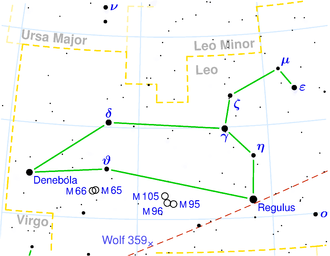NGC 3657
| Galaxy NGC 3657 |
|
|---|---|
![NGC 3657 [1]](https://upload.wikimedia.org/wikipedia/commons/thumb/4/41/NGC3657_-_SDSS_DR14.jpg/300px-NGC3657_-_SDSS_DR14.jpg)
|
|
| NGC 3657 | |
| AladinLite | |
| Constellation | lion |
|
Position equinox : J2000.0 , epoch : J2000.0 |
|
| Right ascension | 11 h 23 m 55.582 s |
| declination | + 52 ° 55 ′ 15.57 ″ |
| Appearance | |
| Morphological type | SAB (rs) c / pec / HII |
| Brightness (visual) | 12.4 mag |
| Brightness (B-band) | 13.1 mag |
| Angular expansion | 1.1 '× 0.7' |
| Position angle | 168 ° |
| Surface brightness | 12.0 mag / arcmin² |
| Physical data | |
| Affiliation | NGC 3631 group LGG 241 |
| Redshift | 0.004053 ± 0.000037 |
| Radial velocity | 1215 ± 11 km / s |
|
Stroke distance v rad / H 0 |
(57 ± 4) · 10 6 ly (17.5 ± 1.2) Mpc |
| history | |
| discovery | William Herschel |
| Discovery date | April 12, 1789 |
| Catalog names | |
| NGC 3657 • UGC 6406 • PGC 35002 • CGCG 268-030 • MCG + 09-19-065 • IRAS F11211 + 5311 • 2MASX J11235555 + 5255155 • GC 2398 • H III 768 • h 876 • 2MASS J11235558 + 5255155 • WISEA J112355. 58 + 525515.4 • LDCE 867 NED016 | |
NGC 3657 is a bar-spiral galaxy with extensive star formation regions of the Hubble type SBc / P in the constellation Leo on the ecliptic . It is estimated to be 57 million light years from the Milky Way and about 20,000 light years across. Together with six other galaxies, it is considered a member of the NGC 3631 group ( LGG 241 ).
In the same area of the sky are u. a. the galaxies NGC 3631 and NGC 3656 .
The object was discovered by Wilhelm Herschel on April 12, 1789 .
